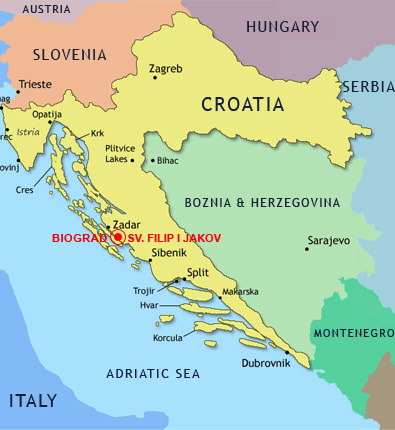Location
 Biograd na Moru
Biograd na Moru
City and port in northern Dalmatia, is situated 28 km south of Zadar (the main city of Zadar County) and, according to the 2001 Census, the town (without its surroundings) counts 5,259 inhabitants. It is located on a small peninsula and on the mainland. To the north there is Bošana Cove and to the south Soline cove. The islands of Planac and St. Catherine (with a lighthouse) are in front of the town. The average temperature in January is 7 °C, while in July it is 24.5 °C, with an average rainfall of 840 mm. Soline Cove has a large sandy beach open to the public and surrounded by a pinewood. Biograd is a local, commercial and traffic center well connected with its hinterland, surrounding coastal localities and small towns on the island of Pašman.
The economy is based on agriculture, fishing and tourism. Biograd is a ferry port for the island of Pašman. It is situated on the coastal road Zadar - Split (M2, E65). Biograd is the center of the riviera that covers Sv. Petar na Moru, Turanj, Sv. Filip i Jakov, Biograd, Pakoštane and Drage, as well as localities on the island of Pašman.: Tkon, Kraj, Pašman, Barotul, Mrljane, Neviđane, Dobropoljana, Banj and Ždrelac, and Vrgada on the island bearing the same name.
Thanks to its position on the most indented part of the Adriatic coast, this region offers excellent possibilities for nautical tourism and sailing as few places on the Mediterranean do. Three national parks are located in its proximity: Paklenica, Kornati archipelago and Krka Falls, and there are also nature parks such as Telaščica and Lake Vrana.
Besides its cultural and historical heritage, Biograd is also known for its lovely beaches, picturesque coves and various accommodation possibilities. Many town restaurants offer home made specialties and international cuisine.
The Biograd tourist development started between the two World Wars. Its first guests, from the Czech Republic, started coming to Biograd in the 1920's. The first hotel was built in 1935 on the sight of today's Hotel Ilirija. Numerous cultural and entertainment programs and sports events are on the summer months' program, folk feasts in open spaces, by the water polo pool near Hotel Ilirija, and in the cinema area, while sports tournaments take place regularly.
The picturesque Pašman Canal, with its many islets and islands, protects Biograd and its Riviera from the strong sea winds, which is an advantage for bathers and boaters. Excursions to the Kornati Islands are possible, as well as excursions to the nearby Telaščica Nature Park. Lake Vrana is at 7 km distance from Biograd, and it is the biggest lake in Croatia, rich with freshwater fish. Fishing excursions are also organized.
Biograd has one of the biggest and best equipped tennis camps on the Adriatic. It consists of 14 tennis courts with earth base and 6 fields with hard base. It is situated in a pinewood, next to the beach. Biograd offers excellent possibilities for sailing and diving, as well as sailing and diving courses.
Biograd is a port visited by boaters whose destination is the Kornati archipelago. Regattas, sailing school and other nautical activities are organized throughout the year. The marinas in Biograd have 1000 sea berths and 200 places on land, and they are open all year round.
Sveti Filip i Jakov
On the area of the present town of Sv. Filip i Jakov, in ancient history, almost three centuries ago, there was a small Liburnian settlement whose ruins can still be seen in dry walls and grave-mounds that contained archaeological finds kept nowadays in the Biograd Museum. After the arrival of Romans in the 1st century, landed estates and country mansions were built for veteran Roman soldiers, so the ruins of these buildings can still be found in hinterland not far from the church of Sv. Roko, as well as in the coastal area in the direction of Biograd. Today, the ruins can be seen at the location called "Kapelica" and opposite to Sv. Filip i Jakov, on the island of Frmić we have the remains of a Roman cistern from late antiquity.
After the arrival of Croats this area gained in value because of the vicinity of the royal town of Biograd that also had estates in the hinterland of Sv. Filip i Jakov. Thus, around the present church of Sv. Roko there was a village called Rogovo and today; here is also the already mentioned church from the 11th century and ruins of a citadel known to us as Dvorine.
Rogovo had the shortest way to the sea, at the present location, where back in the 12th century there was only a small church dedicated to St. Philip and Jacob (Sv. Fillip i Jakov) that was destroyed and later the village was named after it. In the 15th century the name "San Filip e Giacomodi Rogovo" was mentioned for the first time, i.e. this small village still belonged to Rogovo and was therefore called Rogovski pristan (Rogovo quay) due to the quay that was here together with other outbuildings.
Today's old town centre developed in the 16th and for the most part in the 17th century. Upon entering the old town centre one can immediately notice a 17th century Kaštel (citadel) with engraved coat of arms of an abbot from Rogovo ifrom the 15th century. The church of Sv. Mihovil was mentioned already in the 16th century but was destroyed by Turks and thus in 1707 today's church with a beautiful bell tower was erected.
There are ruins of the castle Benedinktinski dvor (in Sv. Filip i Jakov there was also a port of Benedictine abbey on Rogovo). The church of Sv. Roko belongs to the Romanesque period, which is rarely preserved outside of medieval towns on the coast. Therefore, the church belongs to the second category of cultural monuments.